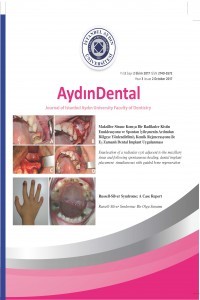MAKSİLLER LATERAL KESİCİ DİŞTE TİP II DENS İNVAGİNATUS’UN ENDODONTİK TEDAVİSİ: OLGU RAPORU
Dens invaginatus, diş dokularının kalsifikasyonundan önce, mine organının dental papilla içerisine katlanması sonucu meydana gelen gelişimsel bir dental anomalidir. Dens invaginatustan etkilenen dişlerin endodontik tedavileri atipik anatomileri nedeniyle zor ve karmaşık olabilir. Bu olgu raporunda Oehlers Tip II Dens İnvaginatus sol maksiller lateral kesici dişin cerrahi olmayan endodontik tedavisi sunulmaktadır. Hastada ağrı ve lokalize şişlik şikâyeti bulunmaktadır. Alınan anamnezde dişin daha önce endodontik tedavi gördüğü, fakat semptomların geçmediği öğrenilmiştir. Daha önce yapılmış olan kanal dolgusu sökülerek her iki kanala geleneksel kök kanal tedavisi uygulanmıştır. Takip radyografilerinde periapikal iyileşme izlenmiştir ve diş asemptomaktir.
Anahtar Kelimeler:
Tip II Dens Invaginatus, Dens In Dente, Dental Anomali, Maksiller Lateral Kesici, Periapikal Lezyon, Kök Kanal Tedavisi
ENDODONTIC TREATMENT OF A MAXILAR LATERAL INCISOR TOOTH WITH TYPE II DENS INVAGINATUS: A CASE REPORT
Dens invaginatus is a developmental dental
anomaly that occurs when the enamel organ is
folded into the dental papilla prior to calcification
of dental tissues. Endodontic treatments of the
teeth with Dens invaginatus can be difficult and
complex due to their atypical anatomy. In this
case report, non-surgical endodontic treatment of
maxillary lateral incisor with Oehlers Type II Dens
Invaginatus is presented. The patient complained
of pain and localized swelling. With the anamnesis,
it was learned that the tooth had previously
received endodontic treatment but the symptoms
did not disappear. After the old canal filling was
removed, conventional root canal treatment was
applied. Periapical healing is observed in followup
radiographs and the tooth is asymptomatic.
Keywords:
Tip II Dens Invaginatus, Dens in Dente, Dental Anomaly, Maxiller Lateral Incisor, Periapical Lesion, Root Canal Treatment,
___
- Shadmehr E, Farhad AR. Clinical Management of Dens Invaginatus Type 3: A Case Report. Iran Endod J. 2011; 6(3): 129-132. 2. de Oliveira NG, da Silveira MT, Batista SM, Veloso SRM, Carvalho MV, Travassos RMC. Endodontic Treatment of Complex Dens Invaginatus Teeth with Long Term Follow-Up Periods. Iran Endod J. 2018; 13(2): 263-266. 3. Uzun I, Keskin C, Guler B, Ozdemir O. Management of dens invaginatus type II with periapical lesion: case report. J Istanb Univ Fac Dent. 2015; 49(3): 51-54. 4. Hulsmann M. Dens invaginatus: etiology, classification, prevalence, diagnosis and treatment consideration. Int Endod J 1997; 30(2): 79-90. Raut AW, Mantri V, Kala S, Raut RA. Management of ‘labial’ type of dens invaginatus: A rare case report. J Oral Biol Craniofac Res. 2016; 6(3): 253–256. 6. Heydari A, Rahmani M. Treatment of Dens Invagination in a Maxillary Lateral Incisor: A Case Report. Iran Endod J. 2015; 10(3): 207- 209. 7. Vier-Pelisser FV, Pelisser A, Recuero LC, So MV, Borba MG, Figueiredo JA. Use of cone beam computed tomography in the diagnosis, planning and follow up of a type III dens invaginatus case. Int Endod J. 2012; 45(2): 198- 208. 8. Moradi S, Donyavi Z, Esmaealzade M. Non-Surgical Root Canal Treatment of Dens Invaginatus 3 in a Maxillary Lateral Incisor. Iran Endod J. 2008; 3(2): 38-41. 9. Pallivathukal RG, Misra A, Nagraj SK, Donald PM. Dens invaginatus in a geminated maxillary lateral incisor. BMJ Case Rep. 2015; doi: 10.1136/bcr-2015-209672. 10. Fregnani ER, Spinola LF, Sonego JR, Bueno CE, De Martin AS. Complex endodontic treatment of an immature type III dens invaginatus. A case report. Int Endod J. 2008; 41(10): 913-919.
- ISSN: 2149-5572
- Yayın Aralığı: Yılda 3 Sayı
- Başlangıç: 2015
- Yayıncı: İstanbul Aydın Üniversitesi
Sayıdaki Diğer Makaleler
ORTODONTİK TEDAVİ ESNASINDA GELİŞEN APİKAL LEZYONUN ENDODONTİK VE RESTORATİF TEDAVİSİ: OLGU SUNUMU
MAKSİLLER LATERAL KESİCİ DİŞTE TİP II DENS İNVAGİNATUS’UN ENDODONTİK TEDAVİSİ: OLGU RAPORU
Özge İrem CAN KOLCU, Esra PAMUKÇU GÜVEN, Aslı TOPALOĞLU AK
